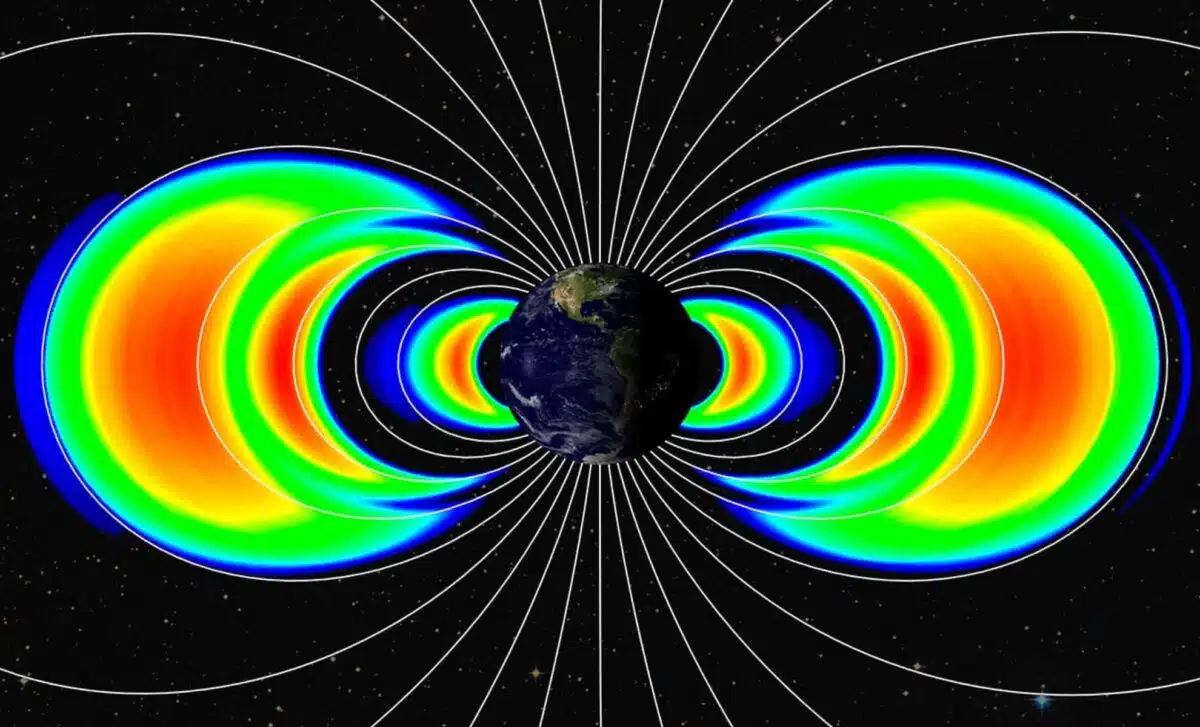
By Lydia Amazouz Published on August 17, 2024
Collected at: https://dailygalaxy.com/2024/08/electromagnetic-wave-earth-radiation-belts/
In a groundbreaking study, two scientists from the University of Alaska Fairbanks have discovered a new type of electromagnetic wave that carries significant amounts of lightning energy into Earth’s magnetosphere.
This discovery could alter the way scientists understand the dynamics of Earth’s radiation belts, which are crucial to protecting life and technology on the planet.
The Discovery: A New Type of “Whistler” Wave
Professor Emeritus Vikas Sonwalkar and Assistant Professor Amani Reddy have identified a previously unknown wave, which they have named the “specularly reflected whistler.” This wave carries energy from lightning strikes that occur in the tropical and subtropical regions of the Earth, known for their frequent thunderstorms.
The energy enters the ionosphere—a charged layer of Earth’s atmosphere—at low latitudes and is then reflected upwards by the lower boundary of the ionosphere, reaching the magnetosphere in the opposite hemisphere.
Their research, published in Science Advances, challenges earlier assumptions that lightning energy entering the ionosphere at these low latitudes was confined there, unable to reach the radiation belts. The radiation belts consist of two layers of charged particles surrounding the planet, held in place by Earth’s magnetic field. These belts are critical in protecting satellites, spacecraft, and modern communication systems from harmful cosmic radiation.
“We as a society are dependent on space technology,” said Sonwalkar. “Understanding the radiation belts and the electromagnetic waves, like those originating in terrestrial lightning, that impact them is vital for human operations in space.”
The Role of the Whistler Waves
Whistler waves are a type of electromagnetic wave that produce a distinctive whistling sound when played through a speaker. Previously, scientists were aware of magnetospherically reflected whistlers, which enter the magnetosphere from higher latitudes and reflect within the magnetosphere. Sonwalkar and Reddy’s discovery reveals that both specularly reflected whistlers and magnetospherically reflected whistlers coexist in the magnetosphere.
Their findings indicate that specularly reflected whistlers likely transport a greater portion of lightning energy to the magnetosphere than their magnetospherically reflected counterparts. This is because the majority of lightning strikes occur in low-latitude regions, where the specularly reflected waves originate. This new understanding could double the amount of lightning energy scientists believe reaches the magnetosphere, adding a significant layer to radiation belt physics.
Implications for Space Technology and Safety
This discovery holds considerable implications for space technology and safety. Earth’s radiation belts contain highly energetic particles that can pose significant threats to satellites, spacecraft, and even astronauts. Prolonged exposure to these particles can damage onboard electronics and increase the risk of cancer for astronauts.
“The energetic particles of the radiation belts can damage electronics and cause cancer,” Sonwalkar explained. This makes understanding the radiation belts and the impact of terrestrial lightning all the more critical for ensuring the safety and longevity of space operations.
Using data from NASA’s Van Allen Probes—which operated from 2012 to 2019—and the World Wide Lightning Detection Network, Sonwalkar and Reddy were able to create a wave propagation model. This model demonstrated how specularly reflected whistlers could be doubling the amount of lightning energy reaching the magnetosphere, opening up new avenues for further research.

Coexisting Whistler Waves: Expanding the Boundaries of Space Research
The discovery that both types of whistler waves—specularly reflected and magnetospherically reflected—exist in the magnetosphere adds a new dimension to the study of Earth’s protective space environment. It shows that the processes occurring in Earth’s upper atmosphere and magnetosphere are far more complex than previously thought.
By revealing the existence of this new type of wave, Sonwalkar and Reddy have also opened the door to deeper investigations into the influence of terrestrial lightning on Earth’s magnetosphere and how this impacts radiation belt physics. Their research has the potential to enhance remote sensing of magnetospheric plasma and improve our understanding of the dynamics of Earth’s protective shields against solar and cosmic radiation.
Moving Forward: The Future of Radiation Belt Research
Sonwalkar and Reddy’s work, supported by grants from the National Science Foundation and NASA EPSCoR, emphasizes the ongoing need to explore the intricate interactions between Earth’s atmosphere, magnetosphere, and space weather. Understanding these phenomena is crucial for mitigating the risks associated with modern space exploration and satellite operations.
As the majority of lightning occurs at low latitudes, the potential for specularly reflected whistlers to transport significant amounts of energy into the magnetosphere is vast. This discovery could lead to further advancements in space weather forecasting, satellite design, and the development of new strategies to protect astronauts and equipment from the dangers posed by the radiation belts.
By enhancing our understanding of the waves that carry energy from lightning into space, Sonwalkar and Reddy have provided valuable insights into the complex dynamics of Earth’s magnetosphere, ensuring that humanity is better prepared for the challenges of space exploration.

Leave a Reply